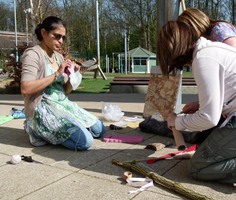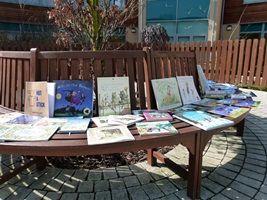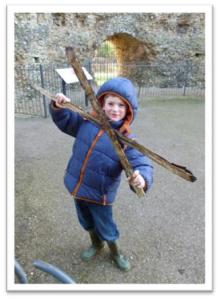
...then the rest of us abandoned them to go eat halloumi. I took them a lot longer to get back out than it did to get in. Were we bad, for sniggering and eating marshmallows at them?
I was delighted to be invited to deliver a couple of workshops at the Slough Early Years Outdoor conference in March. Even better, lovely Sharon Bright and equally marvellous Hazel Thorpe were prepared to indulge my current stick obsession, by positively encouraging me to share my (quite extensive) stick collection with practitioners from across the borough.Sure Start manager Julie Quinn introduced the day by expressing her disappointment at the blazing sunshine outside; we all looked slightly puzzled until she explained she’d hoped for raging storms and pelting rain in order to make the point that outdoor play can be enjoyed in ANY weather. True, of course. However, I don’t think I was the only person rather glad to feel the sun on my back.
Gail Ryder Richardson of Outdoor Matters! began with a rousing address on the benefits of outdoor play for young children, and what she expected to see in the revised EYFS (due out any day now, though I don’t recommend you hold your breath). She made excellent use of an excerpt from Jan White and Siren Films’ documentary Toddlers Outdoors: Play, Learning and Developmentto illustrate how little is needed by way of ‘equipment’ for a toddler to explore and enjoy his environment. In fact, as the audience agreed, the single most important element was the engaged, attentive and respectful practitioner, who supported the child’s fascination with a hill and a stick, patiently and with interest.
My workshop looked at ways of introducing sticks of all shapes and sizes to every day practice, and participants were invited to explore the materials, consider how they could support the six (three plus four) areas of learning and collaborate to create new activities for their settings.

Pampas is one of my favourite sticks and I loved how they were used on this teepee. The wind kept blowing tiny seeds around, as if they were snowflakes.
We began with a bit of stick stomping – always a great way to blow away any cobwebs. I have around a dozen very long, very straight and pretty hefty staffs. We used them to beat out rhythms in sequence, to help us spell out simple words and use our whole bodies to make sounds. Then we used them to show off our balancing skills and hand eye co-ordination, tossing them in the air and catching them… well, mostly catching them. I explained that with young children, I’d provide staffs half this size – taller than the children’s bodies but not so substantial that they become unwieldy.

Discussing how to arrange the sticks in order of size. That odd shaped one has a mind of its own: is it actually the longest, we debated? It was certainly the least willing to lie flat.
The conference was themed around challenging outdoor play, with other workshops looking at forest school skills and getting babies and toddlers active and motivated outdoors. My groups examined real tools for making and doing with sticks, discussing the barriers to using tools and sticks in the setting and demonstrating how they’d mitigate risk and supervise the use of tools. Then I set them loose with the stick collection, the tools and a myriad of free and found objects from my *ahem* crammed resources store (endearingly, my husband still calls it the garage).
As always with early years practitioners, latent creativity leapt forth at the first opportunity. Not only were the sticks and the other natural materials employed with wit and flair, practitioners made use of the environment they found themselves in (the courtyard of a very smart, new build school) to inspire their creativity and shape their work. Exactly the point: you don’t actually need a flashy or expensive outdoor space to encourage dialogue, movement, risk taking or socialisation – what you need is enthusiastic, hands-on practitioners, able and willing to help children make the most of the spaces that truly ‘belong’ to them.
We ended the session by cooking halloumi and marshmallows over a fire; the group helped build it, and whilst we did so, they raised issues about safety, permission, food hygiene and insurance plus the questions they’d expect to face if they suggested having an open fire back in their setting. I think (hope) that between us we were able to address all of these in a positive manner. Certainly in the ‘my next step’ postcards I asked the group to fill out, many noted that by the time I’d posted the card back to them, they’d have tried out some form of fire in their setting, be it incense sticks or nightlights, or a full campfire.

Conversation, collaboration, creativity - this group made a beautiful washing line, with stunning and mysterious shadows cast onto the paving.
A super sunny day and a truly eager crowd at Slough; the buzz of conversation over (a spectacularly delicious and locally sourced) lunch confirmed that everyone had connected with the morning’s discussions and endeavours. I wasn’t attempting to offer the participants forest school ‘lite’ with my workshop; I admit to one or two ‘issues’ around forest schools, but that’s for another time.

The venue had its own woodland right on the edge of the grounds - what a amazing resource to have available every day.
There is a place for large, inherently risky natural materials IN the setting, EVERY DAY. Sticks are not just for the woodland – they offer infinite opportunities for free play, directed play, purposeful learning, personal investigations and collective fun. We all saw the potential for using these fabulously sensory and tactile objects (voted #1 toy of all time) in a different way in the setting; separated from the woodland, each stick becomes special. Even in the brief time they had together, participants began to feel a connection with their stomping stick: evaluating its weight; testing its structural qualities; feeling its texture and shape and anticipating how it would respond to their movements.
I’m hoping for nods of recognition from the participants in my workshops, when their own voices drop onto their doormats in the form of their handwritten evaluation postcards in four weeks’ time…













 Junior PLL the Younger is studying castles this half term and there is plenty of building and exploring action going on in and out of the Reception year classroom at his school. Getting into the spirit, we took a trip to a local castle with friends A and P and their parents. Two years ago we all made a similar trip to Portchester Castle, when Junior PLL the Senior and his class ‘did castles’. Portchester has a huge enclosure, with a pretty well preserved square keep in one corner, a deep and excitingly dangerous moat (dry!), ramparts to climb and amazing views south over the English Channel and north up towards the South Downs.
Junior PLL the Younger is studying castles this half term and there is plenty of building and exploring action going on in and out of the Reception year classroom at his school. Getting into the spirit, we took a trip to a local castle with friends A and P and their parents. Two years ago we all made a similar trip to Portchester Castle, when Junior PLL the Senior and his class ‘did castles’. Portchester has a huge enclosure, with a pretty well preserved square keep in one corner, a deep and excitingly dangerous moat (dry!), ramparts to climb and amazing views south over the English Channel and north up towards the South Downs. The Junior PLLs are having a Star Wars moment (week /month / year) so sturdy sticks from a collapsed chestnut paling fence were soon put into service as lightsabers. It wasn’t long before they became swords and jousting poles as the children began to visualise themselves as knights and peasants living in and around the castle rather than space cowboys. Odiham has a broadly circular footprint , and the ground around the base undulates, encouraging they boys (sorry, knights) to gallop everywhere which inevitably resulted in muddy trousers. Our boys know they won’t get much ‘I fell over’ sympathy unless there’s actual bones on display or significant blood loss, so we were able to continue admiring the delicate patterns made by frost on the castle’s etched glass signage.
The Junior PLLs are having a Star Wars moment (week /month / year) so sturdy sticks from a collapsed chestnut paling fence were soon put into service as lightsabers. It wasn’t long before they became swords and jousting poles as the children began to visualise themselves as knights and peasants living in and around the castle rather than space cowboys. Odiham has a broadly circular footprint , and the ground around the base undulates, encouraging they boys (sorry, knights) to gallop everywhere which inevitably resulted in muddy trousers. Our boys know they won’t get much ‘I fell over’ sympathy unless there’s actual bones on display or significant blood loss, so we were able to continue admiring the delicate patterns made by frost on the castle’s etched glass signage. d see.
d see. “Why are these bars here – who put them there?”
“Why are these bars here – who put them there?”

